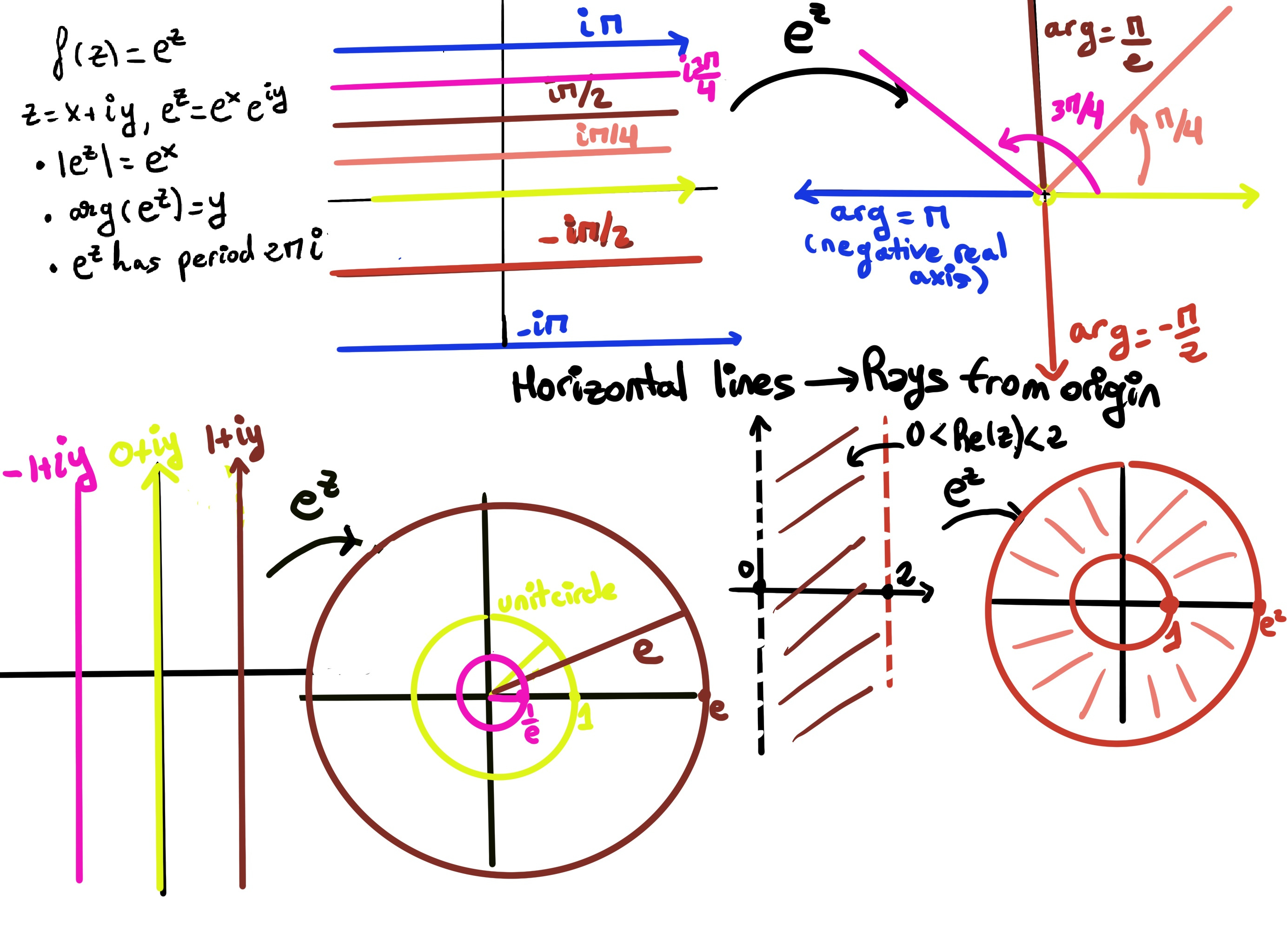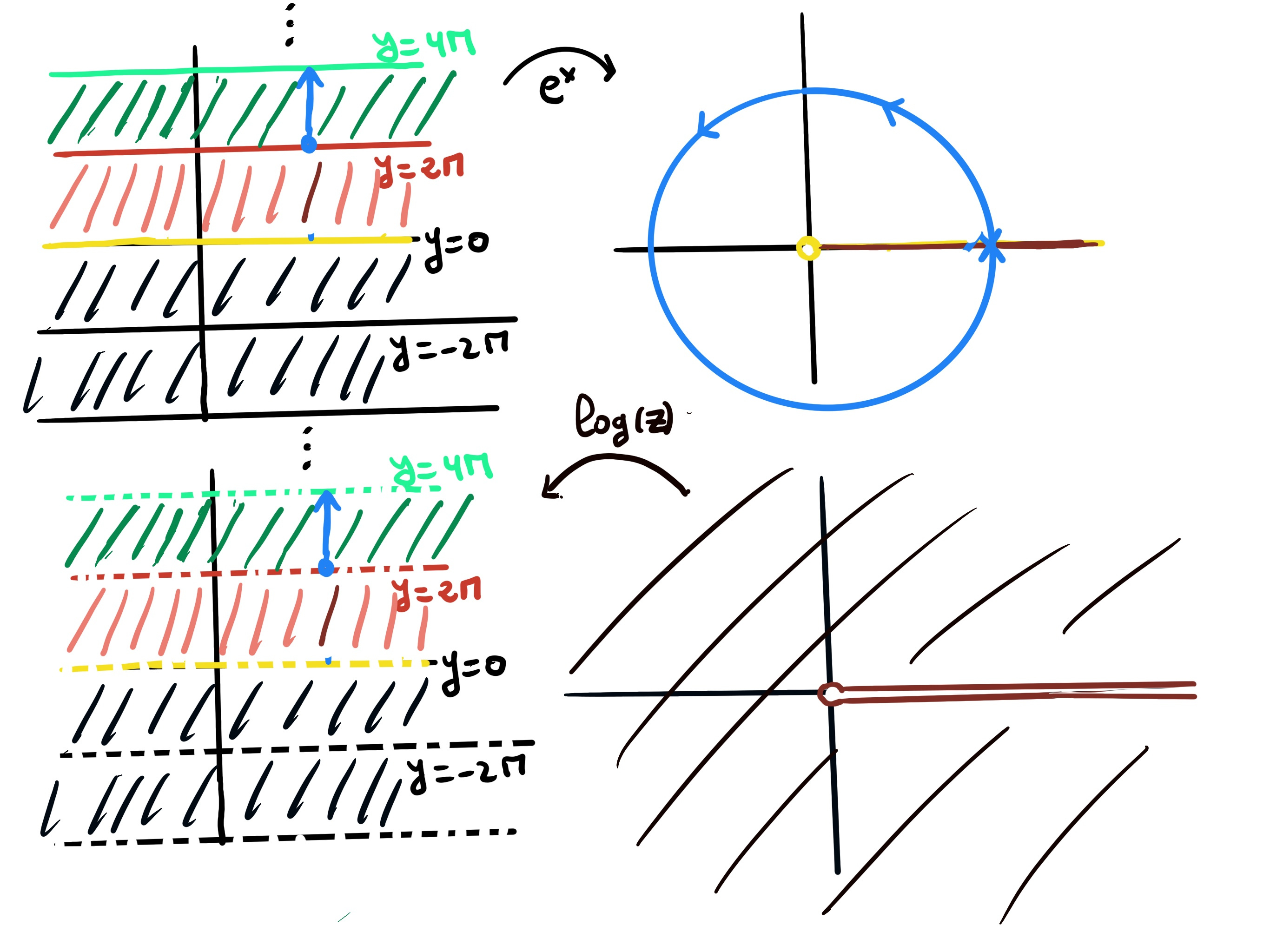
|
 |
 |
To raise new questions, new possibilities, to regard old problems from a new angle, requires creative imagination and marks real advance in science, Albert Einstein.
Any fool can make things complicated, it requires a genius to make things simple, E.F. Schumacher

The complex exponential function, denoted as eᶻ or exp(z), is one of the most important functions in all of mathematics. It is the unique entire function that extends the real exponential function eˣ to the complex plane. This function is not only entire but also periodic.
To define the complex exponential function, we seek a function f: ℂ→ℂ that satisfies two key properties:
Let z = x + iy, where x, y ∈ ℝ. f(z) = f(x + iy) =[1] f(x)·f(iy) =[2] eˣ·f(iy)
Writing f(iy) = A(y) + iB(y), f(z) = eˣ·A(y) + ieˣ·B(y), where A(y) and B(y) are real-valued functions of y.
For f(z) to be a well-behaved function, we want it to be differentiable everywhere, which means it must satisfy the Cauchy-Riemann equations. The real and imaginary parts of f(z) are: u(x, y) = eˣ·A(y), v(x, y) = eˣ·B(y). The partial derivatives are uₓ = eˣ·A(y), uy = eˣ·A’(y), vₓ = eˣ·B(y), and vy = eˣ·B’(y).
Applying the Cauchy-Riemann equations, uₓ = vy and uy = - vₓ, we get: eˣ·A(y) = eˣ·B’(y), then, A(y) = B’(y). Similarly, eˣ·A’(y) = - eˣ·B(y), then A’(y) = -B(y).
From these two equations, we can derive a second-order differential equation for B(y): B’’(y) = -B(y) ↭ B’’(y) + B(y) = 0. This linear, homogeneous, constant-coefficient ODE has characteristic equation r² + 1 = 0 ⇒ r = ±i, the general solution is $y(t) = e^{at}(αcos(bt) + βsin(bt))$, where ‘α’ and ‘β’ are real numbers.
From A(0) = 1 and B(0) = 0 ⇒ β = 1, α = 0. Thus, we have uniquely determined the functions A(y) and B(y): B(y) = sin(y), A(y) = cos(y). Substituting these back into the expression for f(z), we arrive at the definition of the complex exponential function, f(z) = eˣ·cos(y) + ieˣ·sin(y) = eˣ(cos(y) + isin(y)).
The exponential function is well-defined for all z ∈ ℂ, entire, consistent with the real exponential, non-zero, periodic with period 2πi ($e^{z+2\pi i}=e^z $), $\frac{d}{dz}e^z = e^z$, and can be represented as a power series $e^z = \sum_{n=0}^∞ \frac{z^n}{n!}$ (it has infinite radius of convergence).
In real analysis, the logarithm is a fundamental function defined for positive real numbers. For a base $ b > 0 $ ($b \neq 1$), the logarithm $ \log_b(x) $ provides the answer to the question: “To what power or exponent must we raise or elevate the base b to obtain x?”. More formally, $\log_b(x) = y \text{ if and only if } b^y = x$, e.g., $\log_{10}(100) = 2$ because $10^2 = 100$, $\log_{2}(8) = 3$ because $2^3 = 8$, $\ln(e^3) = 3$ (natural logarithm with base $e$), etc.
When extending logarithms to the complex domain, the function becomes multi-valued. This arises because complex numbers are represented in polar form as: $z = r e^{i\theta}$ where:
The multifunction nature arises because the argument arg(z) is not uniquely defined. For any integer k, adding $2\pi k$ to the argument gives another valid logarithm: $\log(z) = \ln|z| + i(\arg(z) + 2\pi k)$
Let z ∈ ℂ \ {0}. Consider the solutions to the equation $e^w = z$. We are always going to consider the base e.
If w = u + iv, $e^w = e^{u + iv} = e^u·e^{iv} = |z|e^{i\theta}$.
Hence, u = ln|z| and v ≡ θ (mod 2π), and realize that this expression is perfectly defined because |z| is strictly positive. Therefore, all solutions are w = ln|z| + i(θ + 2πk), i.e., w ∈ log(z).
For a non-zero complex number z, the complex logarithm is defined as the set: log(z) := ln|z| + i·θ, θ ∈ arg(z) where:
Any value of log(z) is a solution to $e^{log(z)} = z$, log(z) = {ln|z| + i(θ + 2πk) : θ ∈ arg(z), k ∈ ℤ} = {ln|z| + iθ : θ ∈ arg(z)} and z ≠ 0, where Arg(z) stands for single-valued choice of the argument (a branch), typically Arg: ℂ \ {0} → (-π, π].
Because the argument is multi-valued, the logarithm function is a multifunction. Since there is no continuous single-valued argument function on ℂ \ {0} → ℝ, therefore there is no continuous single-valued logarithm on all of ℂ \ {0}. The obstruction is topological (a loop around 0 changes the value by 2π).
Recall. A multifunction, also known as a multivalued function, is a mathematical object that assigns multiple values to each input. In other words, it’s a function that can have more than one output for a given input. Multifunctions are useful in modeling real-world phenomena where a single input can result in multiple possible outcomes.
A principal branch is any single-valued selection $Log_α(z) = ln|z| + i\Theta(z), \Theta(z) ∈ (α, α + 2\pi)$ defined on a simply connected cut domain ℂ \ {reiα: r ≥ 0}
For any branch $Log_α$ we have $Im(Log_α(z))=\Theta(z)∈(α,α+2π)$. Thus the image of the branch lies in the horizontal strip {u + iv: u∈R, v ∈ (α, α+2π)}.
A function fₖ : ℂ \ [0, ∞)→ ℂ given by fₖ(z) = log|z| + iθ(z) where θ(z) ∈ arg(z) and 2kπ < θ(z) < 2(k+1)π, k ∈ ℤ is called a brach of the logarithm multifunction. fₖ is continuous.


For z = x + iy, let’s analyze how the exponential $e^{z} = e^{x}(\cos y + i \sin y)$ transform the complex plane:
Proposition. A function fₖ : ℂ \ [0, ∞)→ ℂ given by fₖ(z) = log|z| + iθ(z) where θ(z) ∈ arg(z) and 2kπ < θ(z) < 2(k+1)π, k ∈ ℤ is analytic.
Proof:
Let fₖ(z) = log|z| + iθ(z) where θ(z) ∈ arg(z), 2kπ < θ(z) < 2(k+1)π, and k ∈ ℤ.
The key insight is to use the fact that the logarithm is the inverse of the exponential function, i.e., on ℂ \ [0, ∞), $e^{f_k(z)} = z, h = (z + h) - z = e^{f_k(z+h)}-e^{f_k(z)}$.
Define the Derivative. We start with the limit definition of the derivative for fₖ(z). $f_k(z)^' = \lim_{h \to 0} \frac{f_k(z+h)-f_k(z)}{z+h-z} =[\text{Since fₖ is continuous (*)}] \lim_{f_k(z+h) \to f_k(z)} \frac{f_k(z+h)-f_k(z)}{e^{f_k(z+h)}-e^{f_k(z)}}$
We leverage the continuity of fₖ (*) to change the limit variables from h → 0 to fₖ(z+h) → fₖ(z) where h ∈ B(z; ε) ⊂ ℂ \ [0, ∞). This allows for the substitution p = $f_k(z+h)-f_k(z)$, where $p \to 0 \text{ as } f_k(z+h) \to f_k(z)$
Therefore, $\lim_{f_k(z+h) \to f_k(z)} \frac{f_k(z+h)-f_k(z)}{e^{f_k(z+h)}-e^{f_k(z)}} = \lim_{p \to 0} \frac{p}{e^{f_k(z)}(e^p -1)} = \frac{1}{e^{f_k(z)}}·lim_{p \to 0}\frac{p}{e^p -1} = \frac{1}{z}$. Since the fundamental limit $lim_{p \to 0}\frac{p}{e^p -1} = 1$ evaluates to 1.
This result holds for any z in the domain ℂ \ [0, ∞). Hence, fₖ is analytic at z ∈ ℂ \ [0, ∞) and $f_k^'(z) = \frac{1}{z}$.
Conclusion:
Alternative Proof of Holomorphicity and the Derivative